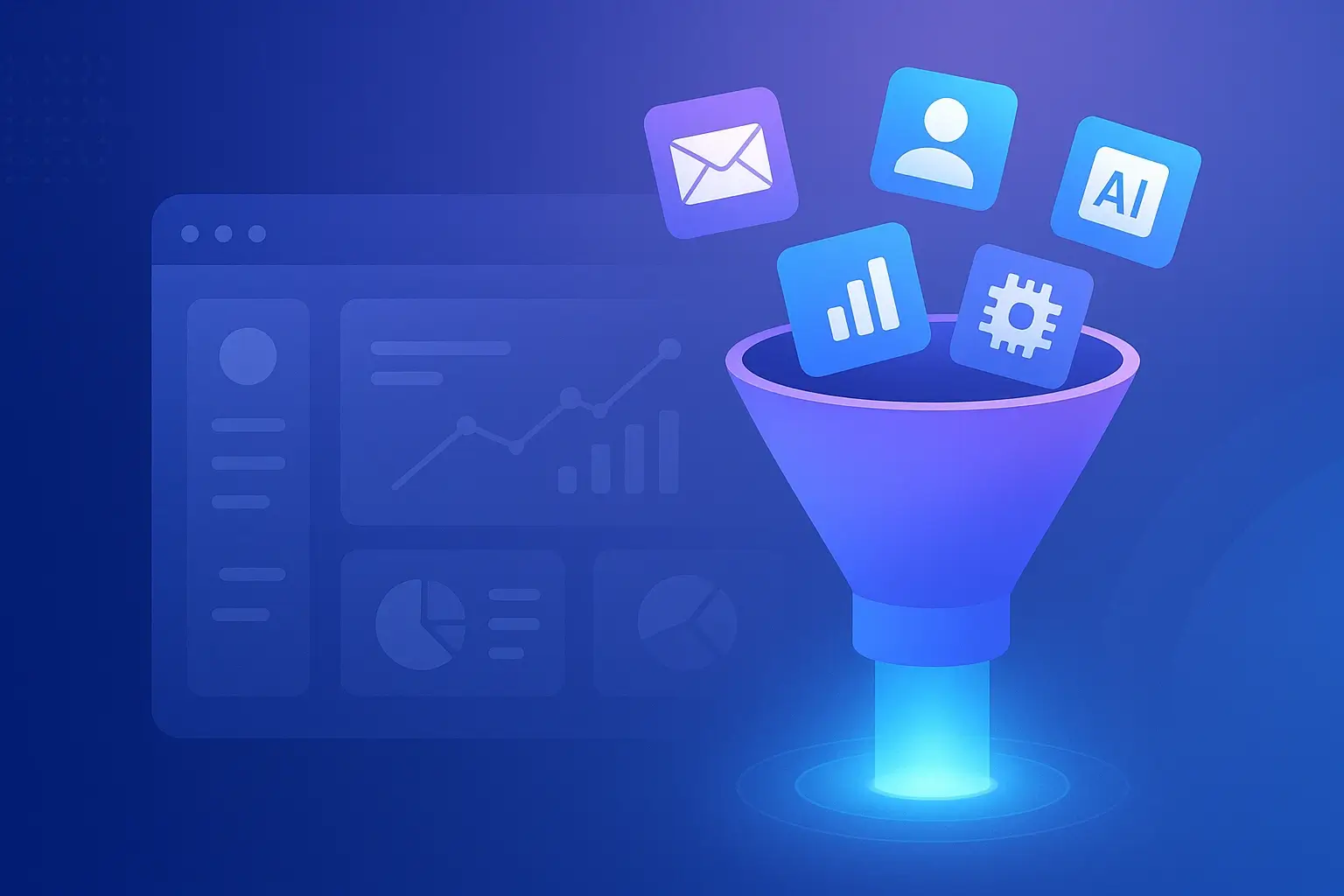
Generating a steady stream of qualified leads is the lifeblood of any B2B business. Without a robust pipeline of prospects, even the best sales teams struggle to hit targets. Lead generation tools exist to solve this problem by automating the sourcing, enrichment, and outreach process. Instead of manually prospecting on LinkedIn or juggling spreadsheets, you can let specialised software handle the heavy lifting while you focus on closing deals.
In this guide, you’ll discover what modern lead generation entails, how to evaluate the right solution for your business, and which platforms truly stand out. We’ll cover five leading tools: SmartReach AI, Apollo.io, enso.bot, Pubrio, and Reply.io, and explain their strengths, drawbacks, pricing, and ideal use cases. By the end, you’ll know exactly which tool is best for you and how to get started.
What Is Lead Generation & Why It Matters
Lead generation is the process of identifying and initiating contact with potential customers. In B2B sales, leads are typically businesses or decision makers who fit your ideal customer profile (ICP). There are two broad categories of leads:
- Inbound leads are generated when prospects find you through marketing content, ads, or referrals and express interest by filling out a form or booking a demo.
- Outbound leads come from your proactive outreach. You identify companies that match your ICP and reach out via email, LinkedIn, or phone to start a conversation.
Both approaches have merit, but outbound is crucial when you want to target specific accounts or quickly scale your pipeline. Doing outbound well requires clean data, personalised messaging, and timely follow‑ups. This is where dedicated lead generation platforms shine. They combine prospect databases, enrichment tools, intent signals, and multichannel outreach in one place, helping you find the right people and contact them at the right moment.
How AI and Automation Improve Lead Generation
The newest generation of lead gen tools leverages artificial intelligence to enhance every step of the process:
- Data enrichment: AI pulls information from multiple sources and fills in gaps such as job titles, company revenue, and technology stacks.
- Intent signals: Algorithms analyse web visits, hiring trends and social activity to surface accounts that are actively researching solutions like yours.
- Personalisation: AI writing assistants generate tailored email copy and LinkedIn icebreakers based on a prospect’s role and pain points.
- Workflow automation: Multichannel sequencing tools schedule emails, LinkedIn touches, and tasks, adjusting the cadence based on recipient behaviour.
By automating these steps, AI‑driven tools free your team from repetitive tasks and increase the chances of meaningful conversations. The key is choosing the right platform for your business size, budget, and market focus.
How to Choose the Right Lead Generation Tool
The market for lead generation software is crowded, and each platform has a slightly different angle. Use the criteria below to narrow your options:
- Data quality and coverage – Check how many companies and contacts are available and whether the database covers your target regions. Look for platforms that continuously verify and update records to minimise bounces.
- Ease of use – A clean interface and guided onboarding will help you and your team get up and running quickly. If you need to learn Boolean logic or complex workflows, be sure there is sufficient support.
- Automation and personalisation – Modern tools should offer multi‑channel sequencing (email, LinkedIn, phone, SMS) and AI‑assisted writing. Conditional logic lets you tailor follow‑ups based on engagement.
- Integrations – Your lead gen platform should sync with your CRM, email provider, and other marketing tools. Native integrations and API access reduce manual exports.
- Pricing and scalability – Consider whether the platform offers a free plan or trial and how pricing scales with user seats, mailboxes, or data credits. Some tools charge per user while others use credit‑based models.
- Support and community – Responsive support and a thriving user community can shorten the learning curve and help you unlock advanced features.
Keep these factors in mind as you compare the platforms below. Each has a slightly different focus, from AI‑powered research to APAC data coverage, so think about which features align with your goals.
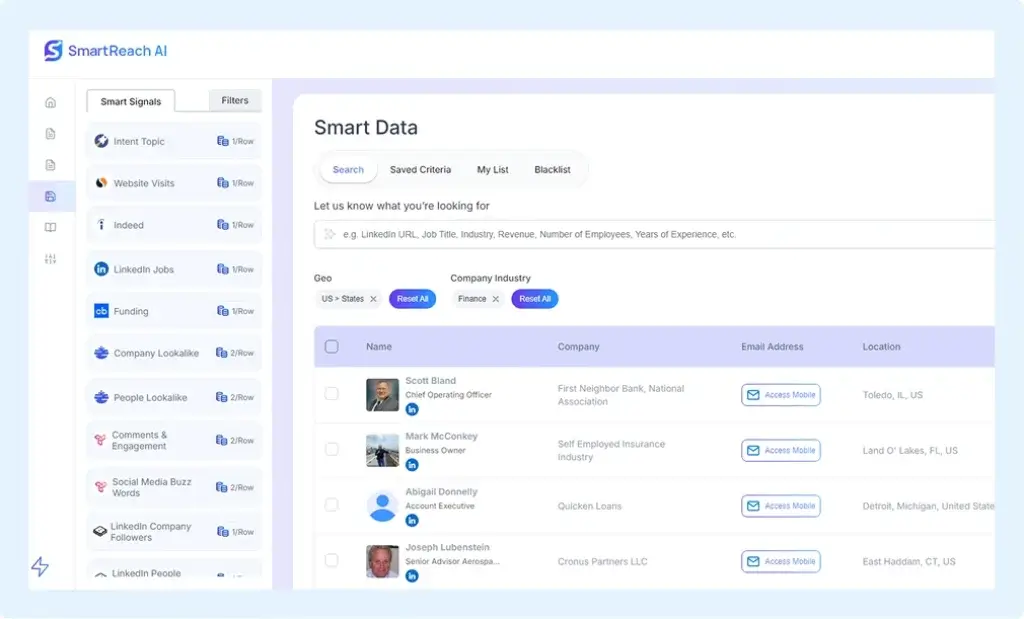
 | Black Friday Deal
| Black Friday Deal
Limited-Time Black Friday Deal: Get SmartReach AI for Life!
Grab the exclusive Lifetime Deal before it’s gone – includes monthly outreach tokens + early access perks.
What Is SmartReach AI?
SmartReach AI is a multichannel sales engagement platform that combines data enrichment, intent signals, and AI‑driven research. Unlike pure email senders, it focuses on building targeted lead lists and orchestrating outreach across email, LinkedIn, WhatsApp, and more. You connect your existing mailboxes, choose an outreach sequence, and let SmartReach handle research and timing. It’s ideal for sales teams that already have an email service provider but need better targeting and automation.
Key Features
- AI‑powered list building – Pull verified leads from multiple data partners and filter by industry, size, tech stack, location and keywords.
- Smart AI research agent – Automate research on company size, funding, technologies, and recent news to personalize outreach.
- Buyer intent signals – Rank prospects based on their likelihood to buy using web activity and intent data.
- Multichannel sequencing – Build workflows that span email, LinkedIn, WhatsApp, and call tasks without switching tools.
- Native integrations – Sync with CRMs like HubSpot and Pipedrive, enrichment tools, and email platforms to streamline workflows.
Pros
- AI‑driven list building saves hours of manual research.
- Intent signals help you prioritise warm prospects.
- Supports multiple channels and integrates with existing tools.
- Excellent onboarding and responsive support.
Cons
- Doesn’t send emails itself; you need a connected sender account.
- Requires setup to sync with CRMs and dialers.
- Lacks a built‑in dialer for voice calls.
Pricing & Plans
| Plan | Monthly Price* | Key Features |
| Email Outreach | $29/user | Basic sequences, analytics, prospect management |
| Email Outreach Plus | $49/user | Email warm‑up, team collaboration, API access |
| Sales Engagement | $99/user | Multi‑channel outreach, CRM integrations, advanced analytics |
| Custom (Enterprise) | Custom | Dedicated success manager, custom integrations |
Who Should Use SmartReach AI
SmartReach AI is best for outbound sales teams and recruiters who need accurate leads and intent data but already have an email sending infrastructure. It suits mid‑sized businesses looking to scale personalised outreach without juggling multiple prospecting tools. Agencies will appreciate the role‑based permissions and collaboration features, while growth teams benefit from AI‑powered research. If you need an all‑in‑one solution that sends emails internally, consider alternatives like Apollo or Reply.io.
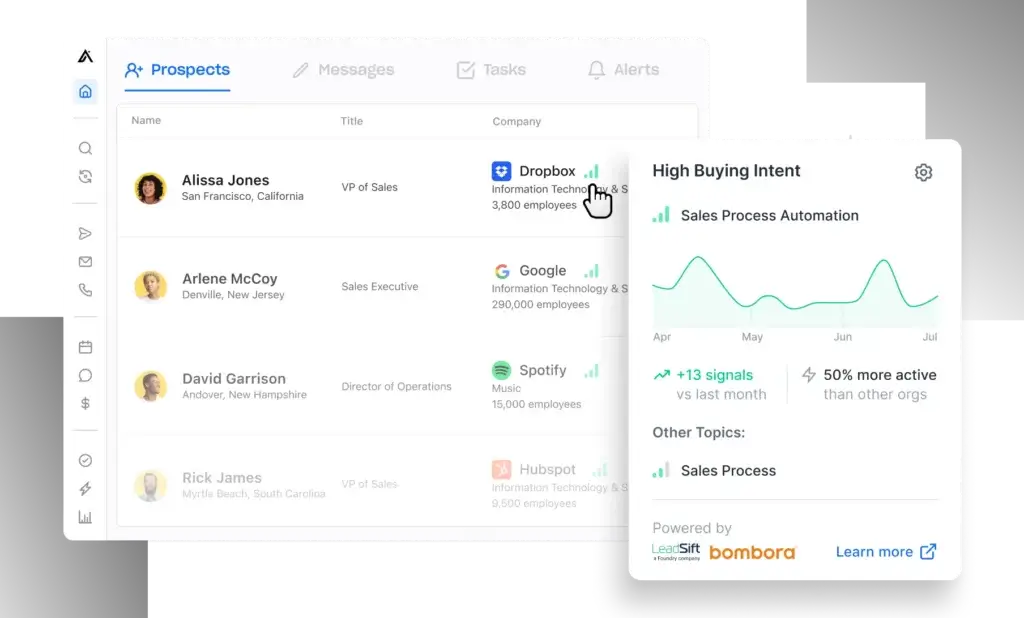
What Is Apollo.io?
Apollo.io combines a massive B2B contact database with CRM, outreach automation, and AI‑assisted writing. With over 260 million contacts and one of the largest verified B2B datasets, it enables users to search for prospects, enrich records, and run email and call sequences from a single interface. It also includes a built‑in dialer, Chrome extension, and pipeline management, making it a robust all‑in‑one sales platform.
Key Features
- Massive contact database – Access over 260 million verified contacts and 35 million company profiles with filters for industry, revenue, hiring signals, and intent.
- Email and call automation – Build multi‑step email sequences, schedule calls, and track outreach activity without leaving the app.
- Integrated dialer – One‑click calling with local presence numbers, call logging and recording for coaching.
- AI writing assistant – Generate personalised cold emails or rewrite messages using AI; run A/B tests on subject lines and copy.
- Chrome extension – Pull contact info directly from LinkedIn or Gmail, add leads to sequences, and view CRM details without switching tabs.
- Deal tracking – Drag‑and‑drop pipeline management with tasks, notes and activities tied to each opportunity.
Pros
- Combines CRM, outreach automation, and data enrichment in one platform.
- Huge contact database reduces the need for external data providers.
- Built‑in dialer and call tracking enhance phone outreach.
- Robust free plan with usable export limits.
Cons
- Steep learning curve due to the depth of features.
- CRM functionality is sales‑focused and lacks the flexibility of dedicated CRMs.
- Advanced features like intent filters and job change alerts are gated behind higher‑tier plans.
- Basic interface design may feel dated compared to newer tools.
Pricing & Plans
| Plan | Monthly Price* | Best For |
| Free | $0 | Solo users; limited emails and exports |
| Basic | $49/user | Email automation, calling, saved lists |
| Professional | $79/user | AI‑assisted emails, A/B testing, job change alerts |
| Organization | Custom | Advanced analytics, governance, and permissions |
Who Should Use Apollo.io
Apollo.io appeals to sales teams that need a single tool for prospecting, engagement and pipeline management. Start‑ups and lean teams benefit from the generous free plan, while mid‑sized companies can leverage the Professional tier for intent data and AI‑powered writing. If you need deep CRM customisation or primarily work outside of outbound sales, a dedicated CRM might serve you better. Teams focused solely on APAC markets may prefer Pubrio for regional depth.
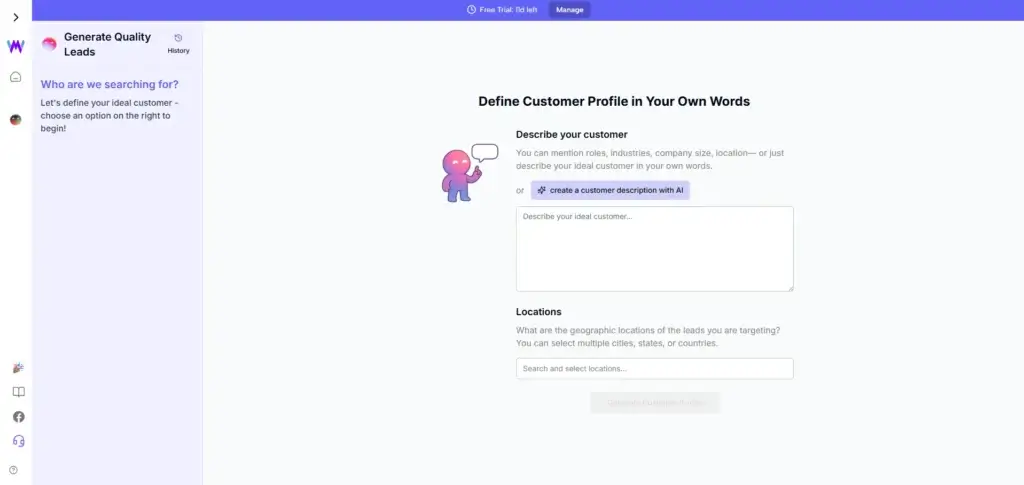
Overview of the AI Agent Marketplace
enso.bot is an AI automation platform offering over 300 specialised agents to handle tasks like content creation, social media design, business plans, and lead generation. Instead of being a single tool, it’s a marketplace where you choose agents that run in the background. For lead generation, enso’s agent finds prospects, drafts outreach messages, and tracks replies without you lifting a finger. The platform is designed for small businesses, freelancers, and non‑technical users who want results without complex setups.
Key Features
- Hands‑free lead generation – Enter your target job title, industry and location; the agent returns a list of leads with company info and email links.
- Automated outreach messages – enso writes personalised emails in your tone and tracks replies and follow‑ups.
- 300+ AI agents – Choose from agents for SEO, social media, research, invoices and more; mix and match to automate your business.
- CSV downloads – Export your leads in CSV format for tracking or uploading into other tools.
- Minimal setup – Designed for non‑technical users; most agents require only a brief description of your goal.
Pros
- Affordable automation compared to hiring freelancers or agencies.
- Industry‑specific agents cover marketing, operations and sales tasks.
- Agents operate in the background once configured, saving time.
- Guided workflows prevent random or irrelevant output.
- Developers can build and sell their own agents on the platform.
Cons
- Limited customisation; agents follow preset workflows.
- Subscription required after the free trial; no pay‑as‑you‑go option.
- Some agents may produce mixed results and require manual editing.
Pricing & Plans
enso offers a straightforward pricing model: a 3‑day free trial followed by a subscription that starts around $49 per month. This grants access to all agents, including the lead generation module. There are no tiers, but usage limits may apply depending on the plan. Because enso is designed for small teams, you don’t pay per seat.
Who Should Use enso.bot
enso is perfect for solo founders, freelancers, and small businesses that don’t have the time or budget for multiple tools or a dedicated team. If you want a simple way to generate leads, create content, and handle administrative tasks from one dashboard, enso delivers strong value. Larger sales teams seeking full control over outreach variables may find it too inflexible.
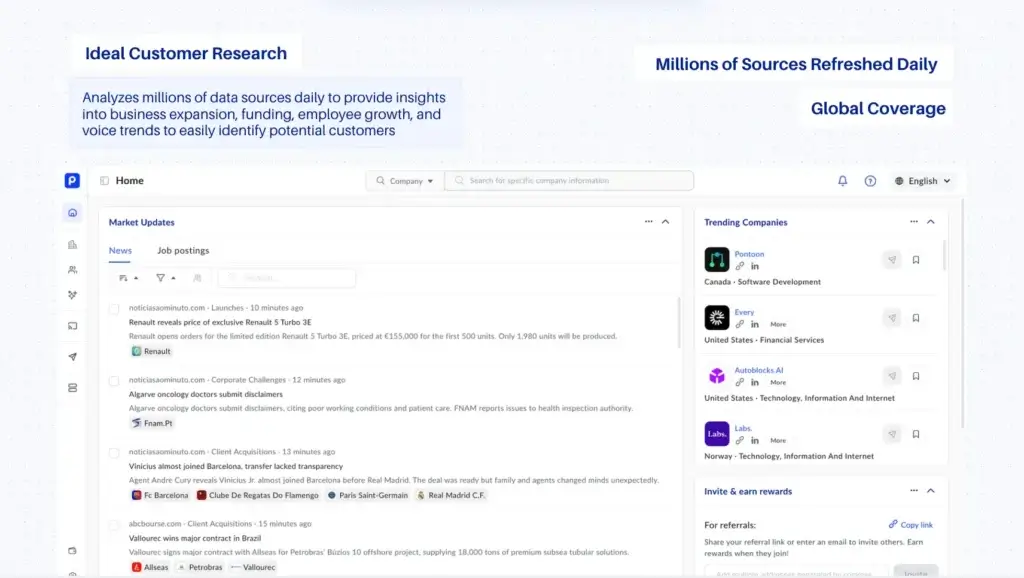
APAC‑Focused Sales Intelligence
Pubrio is a relatively new sales intelligence platform that combines a massive global database with a strong emphasis on Asia–Pacific (APAC) markets. It aggregates data from public and proprietary sources, offering access to over one billion company profiles and 275 million contacts. Its standout feature is deep coverage in countries like Singapore, India, Japan, and Vietnam, where many traditional platforms struggle. Pubrio pairs this data with intent analytics, multi‑channel automation, and managed services.
Key Features
- Universal data access – Search through more than a billion companies and 275 million contacts using filters for industry, size, technology, revenue, and geography.
- Advanced filtering and insights – Combine Boolean logic and filters (technology, funding, hiring signals) to build precise lists; view news, partnerships and leadership changes in each profile.
- Intent signals – Identify companies researching products like yours by analysing website visits, content consumption, and other behavioural data.
- Automated sequences – Launch multi‑channel campaigns across email, LinkedIn, and WhatsApp; schedule tasks and follow‑ups automatically.
- Managed services – Outsource list building, enrichment, and appointment setting to Pubrio’s research team if you lack bandwidth.
- High data accuracy – Pubrio reports around 90 percent accuracy thanks to continuous crawling and manual verification of phone numbers and emails.
Pros
- Deep coverage in APAC regions with verified phone numbers and local data.
- High data accuracy reduces bounce rates and improves connect rates.
- Actionable intent and technology signals help prioritise leads.
- Built‑in multi‑channel automation and Chrome extension simplify workflows.
- Custom research services save time for teams without in‑house analysts.
Cons
- Learning curve for advanced filters and Boolean queries.
- Limited native integrations at present; exports and API connections required.
- Credit‑based pricing may lead to overages for high‑volume users.
- As a newer platform, community resources and integrations are still maturing.
Pricing & Plans
| Plan | Price per Month* | Credits Included |
| Free | $0 | Limited search & export credits |
| Growth | ≈$35 | 900 credits |
| Business | ≈$125 | 4,200 credits |
| Organization | Custom | 100,000 credits and managed services |
Who Should Use Pubrio
Pubrio is a strong choice for companies selling into Asia–Pacific markets or requiring high data accuracy. Small teams will appreciate the Growth plan’s affordable entry point, while larger organisations can scale up to the Business or Organization tiers. If your sales operation depends on a CRM ecosystem or you’re focused solely on North America and Europe, other tools with deeper integrations may be a better fit. For APAC expansion, however, Pubrio’s blend of data depth and intent analytics is hard to beat.
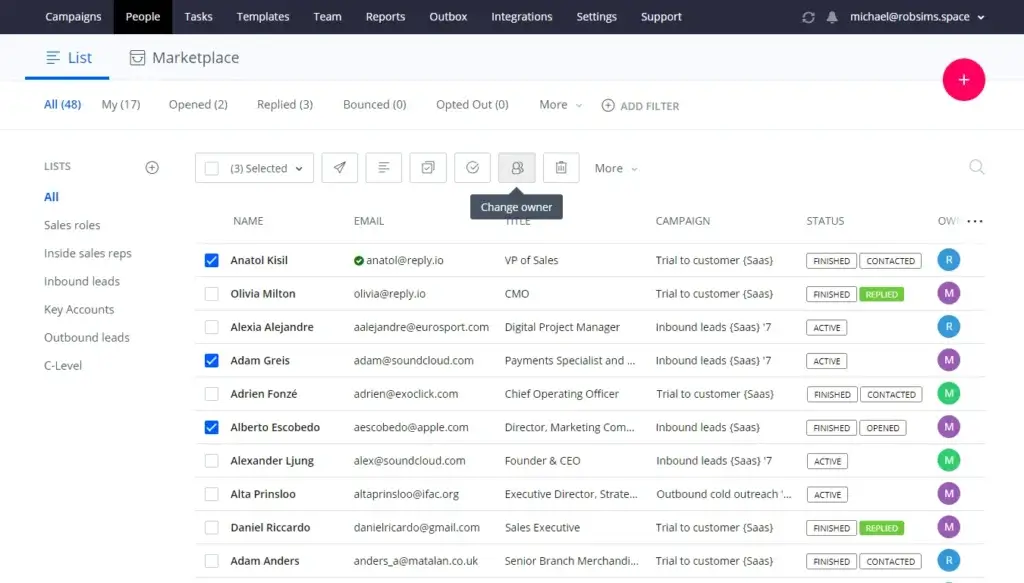
Overview of the Sales Engagement Platform
Reply.io is an AI‑driven sales engagement platform that automates multi‑channel outreach, personalises messages at scale, and helps teams close more deals. It combines a B2B contact database, email sequencer, LinkedIn automation, phone dialer, and a deliverability suite. Its built‑in assistant, Jason AI, generates customised sequences and can even act as a virtual SDR for higher‑tier customers. Reply aims to simplify outreach for sales teams, agencies, and recruiters while ensuring messages land in inboxes.
Key Features
- Multi‑channel sequences – Build workflows that mix emails, LinkedIn messages, SMS, WhatsApp, and calls. Conditional logic adjusts the flow based on prospect behaviour.
- AI personalisation (Jason AI) – Create personalised subject lines, first sentences, and follow‑ups. The AI can respond to incoming emails and schedule meetings.
- Deliverability suite – Includes SPF/DKIM/DMARC checks, inbox warm‑up, custom tracking domains, and email validation credits to keep your sender reputation strong.
- Integrated B2B database – Access over a billion contacts with filters for role, company size, industry, and technology stack. Data credits are included in most plans.
- Reporting and analytics – Track opens, clicks, replies and call outcomes; monitor team performance and clone high‑performing sequences.
- Integrations – Connect with Salesforce, HubSpot, Pipedrive, Zoho, and more. Zapier, Make and API support extend integration possibilities.
Pros
- Comprehensive multi‑channel outreach in a single platform.
- AI‑powered personalisation reduces the time spent writing cold emails.
- Strong deliverability features protect sender reputation.
- Free plan and reasonable starter tiers for testing.
- Advanced plans include AI SDR capabilities for full automation.
Cons
- Pricing escalates quickly when adding mailboxes or higher contact volumes.
- Users report occasional bugs and Chrome extension glitches.
- Limited integrations with certain calendars and CRMs may require workarounds.
- Email‑based support can be slower than live chat or phone support.
Pricing & Plans
| Plan | Starting Price* | What’s Included |
| Free | $0 | Limited sending, 200 data credits, sequence generator |
| Starter | $49/user | One mailbox, 5,000 data credits, basic reporting, integrations |
| Email Blast | $179 | Unlimited mailboxes, up to 50,000 contacts, optional LinkedIn, calls, SMS |
| Multichannel | $99/user | Five mailboxes per user, 200 live data credits, full multichannel sequencing |
| AI SDR | $500+ | Automated outreach for 500+ contacts, Jason AI assistance, custom playbooks |
Who Should Use Reply.io
Reply suits a wide range of organisations. B2B sales teams can automate follow‑ups and personalise at scale. Agencies benefit from the ability to run separate workspaces and white‑label the platform. Recruiters can reach candidates across multiple channels. Solo founders gain access to AI‑generated sequences without hiring extra SDRs, though the cost may be high for very small teams. If you need deeper CRM analytics or operate primarily in APAC, Apollo or Pubrio might be more aligned with your needs.
Comparison Table
Below is a high‑level comparison of the tools covered in this guide. Use it to see which platform offers the data coverage, automation and pricing that fit your needs.
| Tool | Key Strength | Starting Price* |
| SmartReach AI | AI‑driven list building & intent signals | $29/user |
| Apollo.io | Massive contact database & integrated dialer | $0 |
| enso.bot | Hands‑free automation with 300+ AI agents | $49/month |
| Pubrio | APAC‑focused data & intent analytics | $35/month |
| Reply.io | Multi‑channel sequences & AI SDR | $0 (free plan) |
How to Evaluate & Implement Your Choice
Choosing the best lead generation tool isn’t just about comparing feature lists; it’s about aligning the tool with your process and growth goals. Here are practical steps to help you make the right decision:
- Define your ideal customer profile (ICP) – Identify the industries, company sizes, job titles, and technologies that signal a good fit for your offering. Most platforms allow you to save multiple ICP templates.
- Take advantage of free trials – All the tools in this guide offer a free tier or trial period. Use this time to test search filters, sequence builder, and integrations.
- Integrate with your CRM early – Syncing leads and outreach activity with your CRM ensures no prospect falls through the cracks. It also gives your sales team a 360‑degree view of pipeline activity.
- Start small and scale – Begin with a basic plan or a limited number of users. As you refine your outreach process and see results, upgrade to access more credits, seats, or advanced features.
- Track metrics that matter – Monitor response rates, meeting booked rates, and conversion rates. Adjust your outreach cadence, subject lines, and channels based on data.
- Stay compliant – Ensure your outreach complies with local data privacy regulations (e.g., GDPR, CCPA) by using opt‑out links, validating emails and, respecting do‑not‑call lists.
By following these steps, you’ll not only choose the right tool but also ensure a successful rollout that drives measurable results.
Conclusion
Lead generation is essential for B2B growth, and choosing the right tool can make the difference between a full pipeline and an empty calendar. SmartReach AI offers AI‑driven list building and intent signals; Apollo.io delivers a giant contact database with built‑in outreach; enso.bot provides hands‑free automation for small businesses; Pubrio excels at APAC data and intent analytics; and Reply.io pairs multi‑channel sequencing with AI SDR capabilities.
Consider your target market, team size and budget when selecting a platform. Start with a free trial, define your ICP and integrate your chosen tool with your CRM. With the right lead generation solution, you’ll spend less time hunting for prospects and more time closing deals, giving your sales team a competitive edge in 2025 and beyond.
Frequently Asked Questions
1. What is the difference between a lead generation tool and a CRM?
A lead generation tool helps you find and contact new prospects, whereas a CRM focuses on managing relationships and tracking interactions after a lead enters your pipeline. Many lead gen platforms integrate with CRMs so you can seamlessly hand off qualified prospects to sales.
2. Are there free lead generation tools?
Yes. Apollo.io and Reply.io both offer free plans with limited credits for data exports or email sending. SmartReach AI provides a 14‑day free trial, Pubrio has a free tier with limited credits, and enso.bot offers a three‑day trial.
3. Can these tools integrate with my existing CRM?
Most platforms integrate with major CRMs like Salesforce, HubSpot, and Pipedrive. SmartReach connects via native integrations or Zapier, Apollo and Reply offer direct CRM sync, and Pubrio plans to add native integrations while providing API access. enso.bot focuses more on stand‑alone operation, but allows CSV exports for manual uploads.
4. How do intent signals improve lead generation?
Intent signals identify when a prospect is actively researching a solution like yours. They’re based on web visits, content consumption, hiring activity and technology usage. Tools like SmartReach AI, Pubrio, and Apollo surface intent data so you can prioritise warm leads and contact them at the right moment.
5. Do I still need a separate email automation tool?
It depends on the platform. Apollo.io and Reply.io include built‑in email sequencing, while SmartReach AI orchestrates multichannel outreach but relies on connected email accounts for delivery. enso.bot automates email drafting but doesn’t send emails directly. Pubrio handles emails within its sequences for supported channels.
6. What are data credits and why do they matter?
Data credits are tokens that allow you to export contacts or run searches. Tools like Pubrio and Reply allocate a set number of credits per month. If you exceed your allowance, you may need to purchase more. Credits help control costs and ensure fair usage across customers.
7. How accurate are the databases?
Data accuracy varies by provider and region. Pubrio reports around 90 percent accuracy, Apollo relies on continuous verification and crowdsourced updates, SmartReach enriches data from multiple providers, and Reply includes validation tools to reduce bounces. Always test a sample of leads before sending large campaigns.
8. Can I use these tools for inbound marketing?
While primarily designed for outbound prospecting, some platforms support inbound strategies. SmartReach and Apollo allow you to import inbound leads and nurture them with personalised sequences. Reply’s AI assistant can handle inbound replies and schedule meetings. enso.bot and Pubrio are best suited for outbound.
9. Is AI‑generated copy reliable?
AI writing assistants save time by drafting emails and icebreakers. However, you should review and refine the output to ensure it matches your brand voice and addresses specific pain points. Over‑reliance on AI can make messages feel generic.
10. How long does it take to see results?
Results depend on your ICP, messaging quality and outreach volume. Many users see increased response rates within the first few weeks of using a dedicated lead generation tool. Consistency is key, test different subject lines, adjust follow‑ups, and monitor metrics to continually improve.











